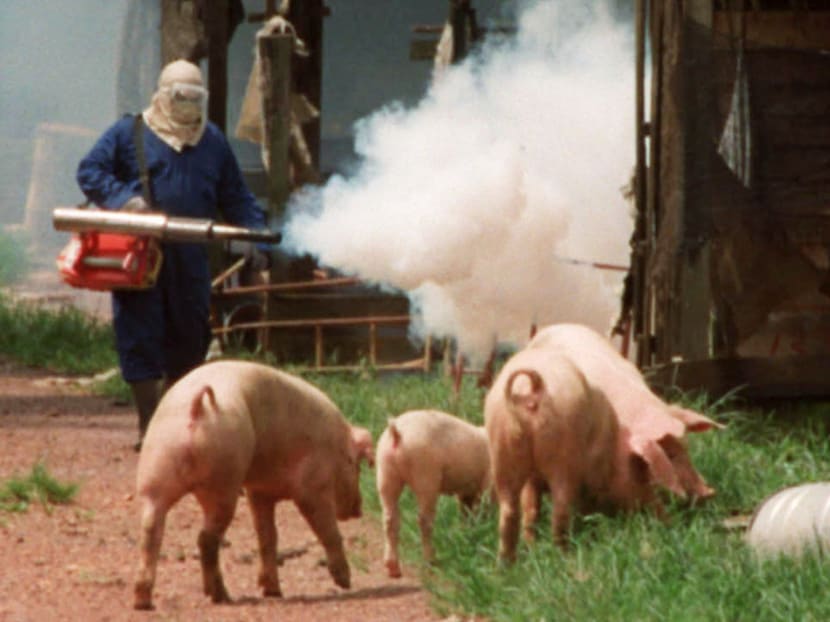Culling of healthy animals hard to justify: Researchers
SINGAPORE — It is very hard to justify the culling of healthy animals from a public health approach that should promote the health of humans, animals and the environment, argue Singapore researchers of a study published recently.

A pig farm being fogged before Malaysian soldiers began shooting the pigs in Sungai Nipah, Kuala Lumpur, in 1999 to fight the Nipah virus outbreak. Infectious diseases expert Paul Tambyah said this is an ‘extreme situation’ where culling may have been justified. Photo: Reuters
SINGAPORE — It is very hard to justify the culling of healthy animals from a public health approach that should promote the health of humans, animals and the environment, argue Singapore researchers of a study published recently.
Their findings were derived from surveys and interviews with experts including officials from the Agri-food & Veterinary Authority (AVA), National Environment Agency (NEA) and the Ministry of Health (MOH).
Although human health remains the priority, the experts were generally not supportive of culling healthy animal populations in response to emerging infectious diseases — especially of wildlife and companion animals.
Of the 32 experts who took part in the qualitative study — published in late-January in the journal Plos One — five were from the Government while the rest were employed in academia, wildlife conservation and other fields.
They recognised that culling of animals was “highly controversial” and “extremely difficult to implement effectively within an urbanised area”, due to public objection and the logistics of quickly containing and killing large numbers of animals, noted the study.
Culling was recently in the news when public uproar ensued after the AVA put down 24 free-ranging chickens in Sin Ming.
The authority initially said it was due to complaints of noise by residents, but later explained that the noise pointed to the chickens’ relatively high numbers, which in turn raised exposure to bird flu in the area.
Culling is a last resort in managing Singapore’s animal population, Minister of State for National Development Koh Poh Koon said in Parliament last month.
The AVA also culls crows to control their population, and has tried other methods such as oral contraceptives and bird deterrent gels for other birds.
The opinion leaders who took part in the study were not named.
The multidisciplinary public health framework that aims to prevent and control emerging infectious diseases that can spread from animals to humans is called One Health.
Singapore’s One Health platform began in 2012 and involves the MOH, NEA and AVA.
The eight authors of the study — funded by the MOH — included Dr Tamra Lysaght of the National University of Singapore (NUS) Medicine’s Centre for Biomedical Ethics, and Dr Michele Marie Bailey and infectious diseases expert Paul Tambyah of NUS Medicine.
The effectiveness of culling domestic and wild animal populations is increasingly coming under scrutiny, after results of a randomised trial in Britain of badger culling (to reduce tuberculosis in cattle) showed the practice to be ineffective in reducing disease transmission, they wrote.
Culling may actually increase disease risk in humans and animals.
A reduction in natural hosts can force the pathogen to seek another animal host which could be even more hazardous for humans and other animals.
Alternatives such as animal vaccinations should be considered, and Professor Tambyah said surveillance and the development of diagnostics is also important.
An “extreme situation” where culling may have been justified was for pigs on Malaysian farms during the 1999 Nipah virus outbreak — because of the high numbers of infected people who were dying, the lack of a vaccine, and pigs being clearly identified as an “intermediate host” of the virus, catching it from bats, he said.
The One Health approach in Singapore worked well in the Group B Streptococcus outbreak of 2015, Prof Tambyah and Dr Lysaght said.
The agencies conducted joint investigations, issued public advisories, and stepped up measures such as banning the use of freshwater fish in all ready-to-eat raw fish dishes sold by retail food establishments.









